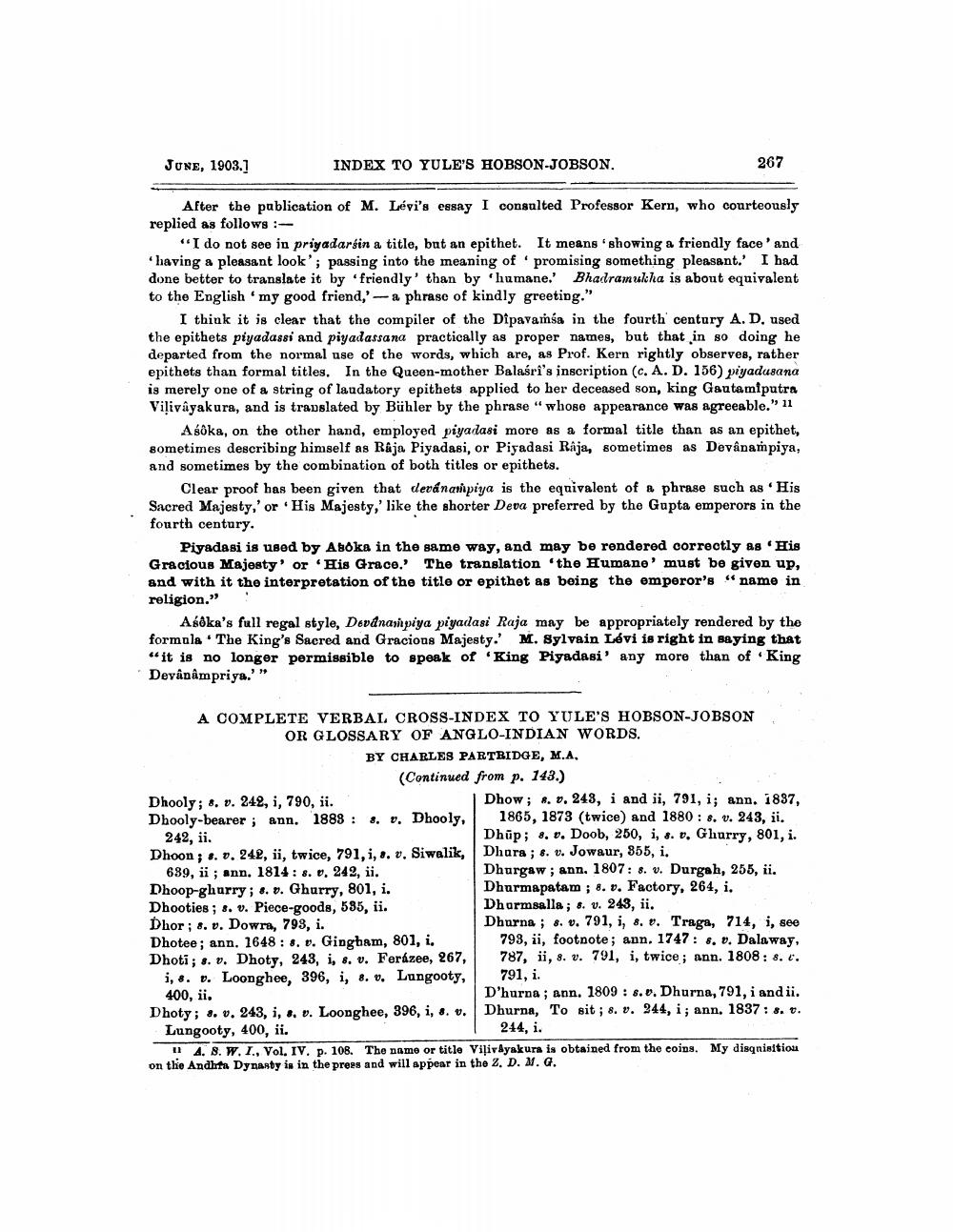________________
JUNE, 1903.1
After the publication of M. Levi's essay I consulted Professor Kern, who courteously replied as follows:
INDEX TO YULE'S HOBSON-JOBSON.
267
"I do not see in priyadarsin a title, but an epithet. It means 'showing a friendly face' and 'having a pleasant look'; passing into the meaning of promising something pleasant.' I had done better to translate it by 'friendly' than by 'humane.' Bhadramukha is about equivalent to the English my good friend,'-a phrase of kindly greeting."
I think it is clear that the compiler of the Dipavamsa in the fourth century A. D. used the epithets piyadassi and piyadassana practically as proper names, but that in so doing he departed from the normal use of the words, which are, as Prof. Kern rightly observes, rather epithets than formal titles. In the Queen-mother Balasri's inscription (c. A. D. 156) piyadusana is merely one of a string of laudatory epithets applied to her deceased son, king Gautamiputra Vilivâyakura, and is translated by Bühler by the phrase "whose appearance was agreeable." 11
Aśoka, on the other hand, employed piyadasi more as a formal title than as an epithet, sometimes describing himself as Raja Piyadasi, or Piyadasi Raja, sometimes as Devânampiya, and sometimes by the combination of both titles or epithets.
Clear proof has been given that devanampiya is the equivalent of a phrase such as 'His Sacred Majesty,' or 'His Majesty,' like the shorter Deva preferred by the Gupta emperors in the fourth century.
Piyadasi is used by Asoka in the same way, and may be rendered correctly as 'His Gracious Majesty' or 'His Grace. The translation 'the Humane' must be given up, and with it the interpretation of the title or epithet as being the emperor's name in. religion."
Asôka's full regal style, Devanampiya piyadasi Raja may be appropriately rendered by the formula The King's Sacred and Gracions Majesty. M. Sylvain Lévi is right in saying that "it is no longer permissible to speak of 'King Piyadasi' any more than of King Devânâmpriya.""
A COMPLETE VERBAL CROSS-INDEX TO YULE'S HOBSON-JOBSON OR GLOSSARY OF ANGLO-INDIAN WORDS. BY CHARLES PARTRIDGE, M.A. (Continued from p. 143.)
Dhooly; s. v. 242, i, 790, ii. Dhooly-bearer; ann. 1888 s. v. Dhooly, 242, ii.
Dhoon; s. v. 242, ii, twice, 791, i, s. v. Siwalik, 639, ii; ann. 1814: s. v, 242, ii. Dhoop-ghurry; s. v. Ghurry, 801, i. Dhooties; s. v. Piece-goods, 535, ii. Dhor; s. v. Dowra, 793, i.
Dhotee; ann. 1648: s. v. Gingham, 801, i. Dhoti; s. v. Dhoty, 243, i, s. v. Ferázee, 267,
i, s. v. Loonghee, 396, i, 8. v. Lungooty,
400, ii.
Dhow; s. v. 243, i and ii, 791, i; ann. 1837, 1865, 1873 (twice) and 1880: s. v. 243, ii. Dhup; 8. v. Doob, 250, i, s. v. Ghurry, 801, i. Dhura; s. v. Jowaur, 855, i.
Dhurgaw; ann. 1807: s. v. Durgah, 255, ii. Dhurmapatam; 8. v. Factory, 264, i.
Dhurmsalla; s. v. 243, ii.
Dhurna; s. v. 791, i, s. v. Traga, 714, i, see 793, ii, footnote; ann. 1747: s. v. Dalaway, 787, ii, 8. v. 791, i, twice; ann. 1808: s. r. 791, i.
D'hurna; ann. 1809: s. v. Dhurna, 791, i and ii. Dhoty; s. v. 243, i, s. v. Loonghee, 396, i, s. v. Dhurna, To sit; s. v. 244, i; ann. 1837: s. v. Lungooty, 400, ii. 244, i.
A. 8. W. I., Vol. IV. p. 108. The name or title Vilivâyakura is obtained from the coins. My disquisition on the Andhra Dynasty is in the press and will appear in the Z. D. M. G.




